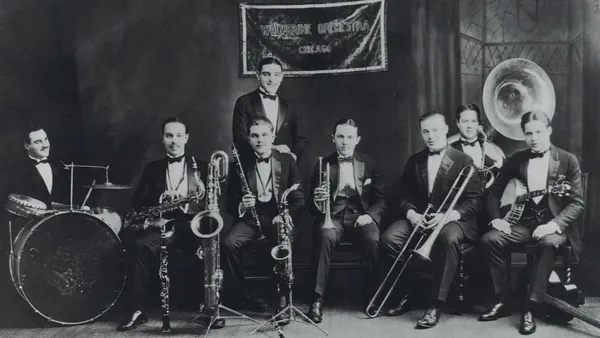 |
| Bix Beiderbecke with his cornet and the Wolverine Orchestra featured in Brigitte Berman’s superb Bix: 'Ain't None Of Them Play Like Him Yet' Photo: courtesy of Brigitte Berman |
Bix Beiderbecke, called a “born genius” by his friend Louis Armstrong, who also provided the quote in the film’s title, died far too young at the age of 28 in 1931. Almost half a century later, between 1978 and 1980, Brigitte Berman interviewed family, friends, and many of the musicians and admirers, including Hoagy Carmichael, Bill Challis, Charlie Davis, Artie Shaw, Spiegle Willcox, Fred Bergin, Doc Cheatham, Matty Malneck, Esten Spurrier, and many more who played with Bix to get a sense of the man who left behind this remarkable music that borders on the otherworldly. A very impressive array of paintings by Edward Hopper visually doubles the effect of the experience.
 |
| Brigitte Berman with Anne-Katrin Titze on Wim Wenders: “His films have meant a great deal to me over the years.” |
Another four decades forward, we are given the gift of a brand new 4K restoration of Bix: 'Ain't None Of Them Play Like Him Yet', co-written with Val Ross, narrated by Richard Basehart, which allows us glimpses into two eras of the past simultaneously, by showing how one remembered the other. Bandleader and clarinettist Artie Shaw states that “Bix made a sound that was never there before” about cornetist Beiderbecke, who rose to fame during a time when ballrooms were big and people loved to dance to live bands and orchestras touring the States.
Bix Beiderbecke, son of German immigrants, grew up in Davenport, Iowa. Musical from the start, he bought his first cornet from a friend for $35, paid in instalments to play along with a recording of the Tiger Rag. 2022 is upon us as the year of the tiger and the joy with which the interviewees, Bix’s first girlfriend Vera Korn among them, talk about their long lost friend is packed with such details.
We hear of the toll the musician’s life took, what it was like to be on tour with the Paul Whiteman Orchestra, what made Bing Crosby show up on time, the racial/geographical divide of the Chicago jazz scene in the Twenties, and how it must have felt to play your composition alone on stage at Carnegie Hall to a packed house in 1928.
The warmth radiating and the transporting tones emanating from Bix’s cornet in this re-edited documentary by the filmmaker make for a must-see watch and listen.
From Toronto, Oscar-winner Brigitte Berman (for her documentary Artie Shaw: Time Is All You've Got) joined me on Zoom for an in-depth conversation on Bix: 'Ain't None Of Them Play Like Him Yet’.
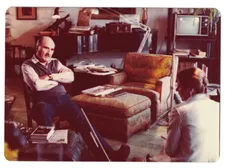 |
| Brigitte Berman interviewing Artie Shaw in1979 Photo: courtesy of Brigitte Berman |
Anne-Katrin Titze: Your documentary is such a wonderful double time travel!
Brigitte Berman: Oh my, yes!
AKT: It allows us to go back to the time of Bix Beiderbecke, the Twenties, and also to the time when you were having the interviews in the late Seventies. Where you thinking of this double travel back in time when embarking on the restoration?
BB: No, it all happened by chance. I was in a very serious car accident and it took a while to recuperate from that. And then came the pandemic and I thought, I’ve got to do something or I’m going to go crazy. I couldn’t start the film that I was supposed to start before my accident, and I still can’t begin it. And I thought, let me look at my Bix film and see what condition it’s in.
Good thing I did that because my visual person told me that part of the digital had broken up and it was great that we had three different digital tapes and we pieced it together with all the good versions. Then he made changes and I made some editing changes and then my sound magician, he put all the new bells and whistles of today onto the soundtrack and took out the hisses on the records, except for a couple of times, I think. He just performed magic with the sound. I am very thrilled and here we are, it’s coming out!
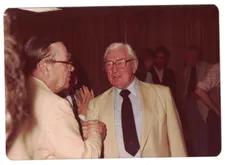 |
| Charlie Davis with Spiegle Wilcox at the Canadian Consulate reception after the very first New York screening of Bix: 'Ain't None Of Them Play Like Him Yet' in 1981 Photo: courtesy of Brigitte Berman |
AKT: It sounds great, it looks great. You say you did make editing changes?
BB: Yes, I put some more movement into it, I changed some cuts a little bit differently, a couple of visual changes, not major. I’m quite a perfectionist. I was pretty proud of the work I’d done as a young filmmaker. And I thought I don’t want to mess too much with that, because it is of then, of the time.
AKT: Which is part of the beauty of it. It shows a different kind of documentary, a different kind of questioning, a different kind of answering. Hoagy Carmichael is the most wonderful interview I have seen in years!
BB: I know! Is he not amazing? I tell you, he was my very first interview that I did. And my line producer Don Haig said to me “If you can get Hoagy Carmichael, I will help you.” So I set out and I got Hoagy Carmichael and he helped me. I needed a lot of help. I was so young, it was my first movie.
AKT: You got them to open up so much. There he sits in his cream-colored cardigan and answers your questions about the past. The style also - I noticed how many of the men wear white belts and the pattern of the tie matches the pattern of the shirt - it’s lovely. And then they say “Would you like me to play it for you?”
BB: Right! And what do you say, but “of course!” You’re talking about Charlie Davis who was one of my favourite, favourite interviews. He was a remarkable man. I was very fortunate and I think they were all glad that the film was being made. At first they were kind of suspicious of me a little bit, especially Bill Challis, who was very protective of Bix, because of all the drinking. He didn’t want this to be a down and out kind of documentary film and not deal with who Bix was as a musician.
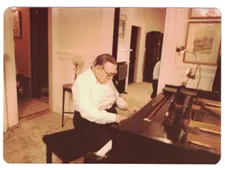 |
| Charlie Davis at the piano Photo: courtesy of Brigitte Berman |
I took my time getting to know all these interviewees. I visited most of them before I did my interviewing and made myself very transparent and forthcoming. I found that that opened them up. With Bill Challis I needed to do two interviews; you may have noticed the two different outfits. The first time he was a little bit tense and didn’t give too much, the second time he completely opened up. I felt very privileged that these men who were incredible musicians, many of whom I got their last interview, really trusted me.
AKT: The film is clearly not just focusing on the alcoholism, this is not The Lost Weekend. There is one comment about Bix seeing snakes on the wall, but the focus is on the music. The interview with Artie Shaw in this film, is that what made you do your Oscar-winning documentary [Artie Shaw: Time Is All You've Got]?
BB: You’re absolutely right. You are more than right. Because when I did his interview - I shot about a 40-minute interview with him - I ended up using only one little clip. So when I showed the film in California, I invited him and Charles Champlin of the LA Times to a press screening on Sunset Boulevard. I was a bit nervous about Artie because he’s got a little ego and is he going to be upset that I only have like a two-and-a-half-minute clip of him. At the end of the film he said “What you put in of me was the right amount.” He felt good about it, he loved the film.
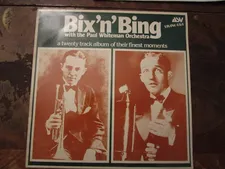 |
| Bix' n' Bing with the Paul Whitman Orchestra, collection Anne-Katrin Titze Photo: Anne-Katrin Titze |
Then I went out for a coffee with him and he asked me “What are you going to do next?” And I had already planned out my answer: “I’ll do a film about you, Mr. Shaw.” I knew I would have to have a really good reason and deliver the reason very very well. And I did. And he paused for a moment and he said “Yep, I like that reasoning. Go ahead, I give you permission.” We began the next day.
AKT: It’s great when he shows up in the Bix film, sporting a moustache. He is such a name that even people who know nothing about the music of that time, will know somewhat something about Artie Shaw [be it only his eight wives who included Ava Gardner and Lana Turner]. But I really do want to talk to you about the beautiful Hopper paintings featured in your film.
BB: Oh I’m so glad.
AKT: There are Hoppers I have never seen before. I of course love the Usherette, which is one of my favourite paintings. I like how you edited them into the narrative. When we see a number of different Hopper road paintings, I think we hear Bing Crosby with the recording of ‘Waiting at the End of the Road.’ Tell me about Hopper and Bix Beiderbecke!
BB: As you know, there was very little footage of Bix available. There’s some extra footage that they have found now, but not much. So I had to think of visuals. I can’t just have men talking. I need to portray that time period. That’s when I went after all the dance halls, old photographs, general footage, anything that evoked a feeling. One day I was at dinner with a girlfriend and she had this big Hopper book lying on the table and she was making dinner. I flipped through it and I saw these paintings and I thought, wow, this feels like what Bix did.
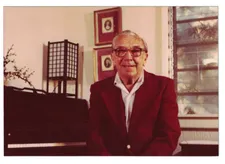 |
| Fred Bergin in 1979 Photo: courtesy of Brigitte Berman |
This has the melancholy, the isolation, that feeling of the late Twenties what he was going through. I decided then that I’m going to film Hopper paintings. There was an exhibition going on in New York, I think at the Whitney or Museum of Modern Art. I ended up getting the permission from all the people who exhibited there and I also found out about other people who had private collections and I would send a photographer to each and every place to take an 8x10 transparency, so I got them from all across the States. I finally had my collection of transparencies and then we did the animation with them.
AKT: It’s beautiful how the paintings express the loneliness, the feeling of isolation, as you say, which also fits very well with the pandemic and the times we are going through. It’s the right time to indulge in this.
BB: You are so right! Isn’t that interesting, that isolated feeling, it echoes, doesn’t it?
AKT: I don’t know if you’ve seen the short films Wim Wenders made of Hopper paintings for the Fondation Beyeler in Switzerland?
BB: Yes! I love his work, he’s one of my favourite directors. Thank you for mentioning him.
AKT: I am going to also mention our conversation to him.
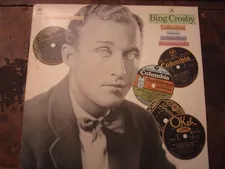 |
| Bing Crosby Waiting At The End Of The Road featuring Bix Beiderbecke with the Paul Whiteman Orchestra, collection Anne-Katrin Titze Photo: Anne-Katrin Titze |
BB: Absolutely, yes! I like to watch people’s films because they speak to me and they drive me onward and give me ideas. And Wim Wenders, maybe also because he’s German and I’m German, there’s a bit of a similarity. I know he’s a bit of a loner himself and so am I a little. His films have meant a great deal to me over the years.
AKT: There is also a German connection to Bix Beiderbecke. A family friend in your film comments that Bix was “born into a German family where you had to be well-dressed all the time.”
BB: That’s right. It was Helen Bettendorf, she was a family friend. Did you see how well-dressed she was?
AKT: Yes.
BB: What I loved was Vera Korn with her earrings that matched what she was wearing. And you’re right, everybody was so impeccably dressed.
AKT: Making an effort is good.
BB: It meant a great deal to them that I was making this film. Both in LA and in New York I got them together and invited them to a screening.
AKT: Vera Korn was Bix’s first girlfriend! How amazing is that to have her in the film after all this time!
BB: Yes, she saw it in Davenport [Iowa]. And she clearly remembers him vividly.
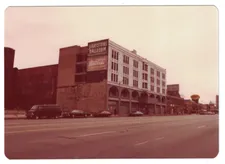 |
| Graystone Ballroom when Brigitte Berman filmed Bix: 'Ain't None Of Them Play Like Him Yet' Photo: courtesy of Brigitte Berman |
AKT: First love! Talking of inspiration, ‘In a Mist’ was inspired by a sandpiper walking on the shore?
BB: Well, not quite. I know Fred Bergin talks about that. But I think that ‘In a Mist’ and the other piano piece are part of one long piano piece. There are four of them and they’re very similar. The ocean gave me the feeling of what I hear in ‘In a Mist’ and I wanted the rising of the sun. I went to a place to film the sunset where there was an old dancehall and the woman at the hotel told me later that they hadn’t seen the sun in five weeks. She didn’t want to disappoint me and there we had a great sunny morning sunrise. When I listen to Bix Beiderbecke’s music, each piece gives me a certain feeling that kind of echoes in myself. I let ‘In a Mist’ run because it’s the only piece of him that we have a recording of. Except for Charlie Davis who remembers ‘Cloudy.’
AKT: You chose the quote from Louis Armstrong for the title. He also called Bix a “born genius.”
BB: I knew that Louis Armstrong was a good friend of Bix Beiderbecke, they jammed a lot together. I had made a film about the Black community in Toronto, which was also a very important film for me. I knew how for these musicians race, colour fell by the wayside. We jam together, we play together, we may be playing at opposite ends in Chicago, but after the midnight hour, after we finish, we’re together and we jam. That’s how Bix and Louis got together.
 |
| Anne-Katrin Titze’s Still Life with Wim Wenders postcard Two Or Three Things I Know About Edward Hopper, featuring Tom Farrell and Bis ans Ende der Welt Soundtrack LP Photo: Anne-Katrin Titze |
Louis really inspired Bix when he would travel up the Mississippi and Bix would hear him on the boat. When I heard about Louis’s voice recording, of course he was dead, I tracked it down. It is part of a radio documentary about Bix Beiderbecke a long time ago and I got the rights to use his voice. He gets the tragedy of Bix better than anybody else does in the film when he says: “He was a born genius but they crowded him too much with love.”
The adoration, wanting to hear him play, the admirers, it never ended, it went on all night in the speakeasies that had booze, etc., etc. It was not a healthy time. Louis knew what some of these people were doing to him. I did not put this particular quote in the film by Louis, but he ended up saying “They killed the goose that laid the golden egg.” It’s also a statement from that interview. He got Bix and what it was like. You’re never left alone. That’s very much today as well.
AKT: Totally, also being on tour. Under very different circumstances, yet still the same thing, the hotel rooms, the waiting.
BB: Absolutely.
AKT: On the one hand, there was the being crowded with love from these strangers…
BB: Yes, these were strangers.
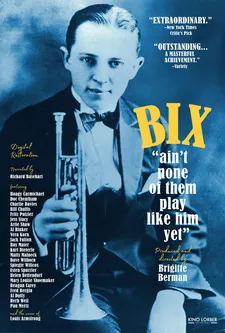 |
| Bix: 'Ain't None Of Them Play Like Him Yet' poster |
AKT: At the same time, and this is a very powerful moment in your film, his own parents never opened the packages he sent of his recordings. He returns home, he has reached the peak of his fame, of his career, went as far as he could rise, and his parents didn’t even open his packages!
BB: Not one! It’s very very sad. You know what’s interesting, he was always considered the black sheep of the family. His brother Bernie who was older, he was the righteous one the son who made it. Well, after Bix had died and then the parents died, Bernie wasn’t working, he didn’t have a job. The town felt sorry for him and gave him the job of keeping the cemetery. Lo and behold, suddenly people would start coming to the cemetery to find Bix’s grave. Here he was showing the grave to all those people of the brother who was the “black sheep.” I always found that remarkable.
AKT: Did you see a recent documentary called Film, The Living Record Of Our Memory, directed by Inés Toharia?
BB: No, should I see it? Where did you see it? I like the title!
AKT: It was at the 12th edition of DOC NYC and it’s a great documentary on archiving and film restoration. Wim Wenders is in it as well.
BB: Oh wow.
AKT: Thank you so much for bringing your Bix film back and for this conversation.
BB: Lovely. That was great. It was a joy to talk with you.
Bix: 'Ain't None Of Them Play Like Him Yet' screens at Metrograph in New York till February 8 and streams on Metrograph At Home through Tuesday, February 15.





















